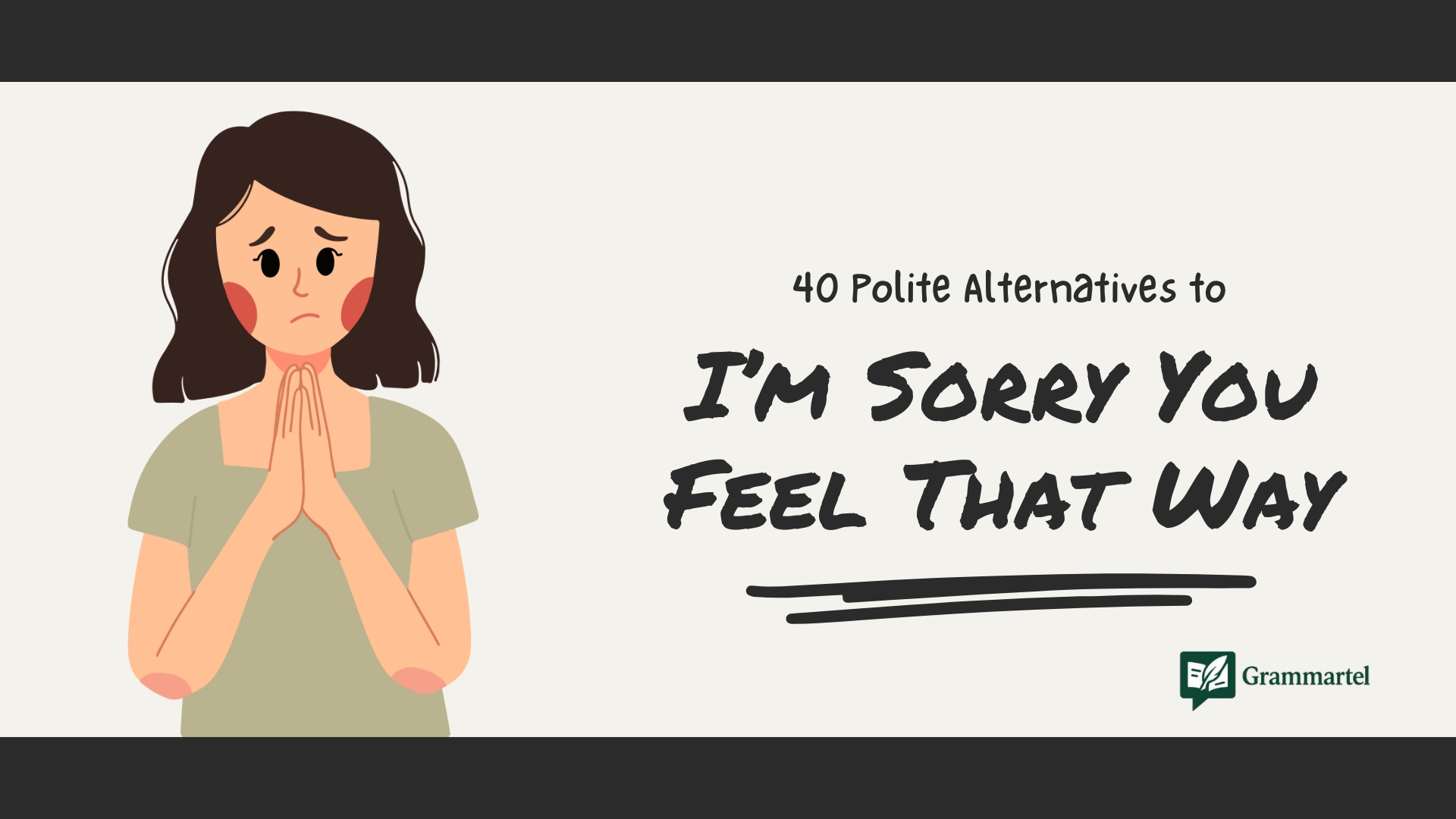Saying “I’m sorry you feel that way” can sound cold or dismissive, even if you don’t mean it that way. It often shuts down the conversation instead of helping. Sometimes, what you really want is to show empathy, keep the peace, or explain yourself without making things worse. That’s where polite alternatives come in. In this guide, we’ll explore 40 thoughtful phrases—plus real examples—that can help you respond with care, respect, and understanding.
What Does “I’m Sorry You Feel That Way” Mean?
“I’m sorry you feel that way” isn’t a full apology. It doesn’t mean, “I’m sorry for what I did.” Instead, it recognizes someone’s emotions without admitting fault.
It often sounds dismissive because it shifts the focus to the person’s feelings, not the action. But sometimes it’s just a polite way to acknowledge emotions when you don’t agree.
When to Use “I’m Sorry You Feel That Way”
- When you don’t think you’re wrong
You can show empathy without taking blame. - When a conversation is stuck
It can help end a heated discussion. - When you need to keep boundaries
It respects the other person’s feelings while standing by your decision.
40 Polite Alternatives to “I’m Sorry You Feel That Way”
1. I hear what you’re saying
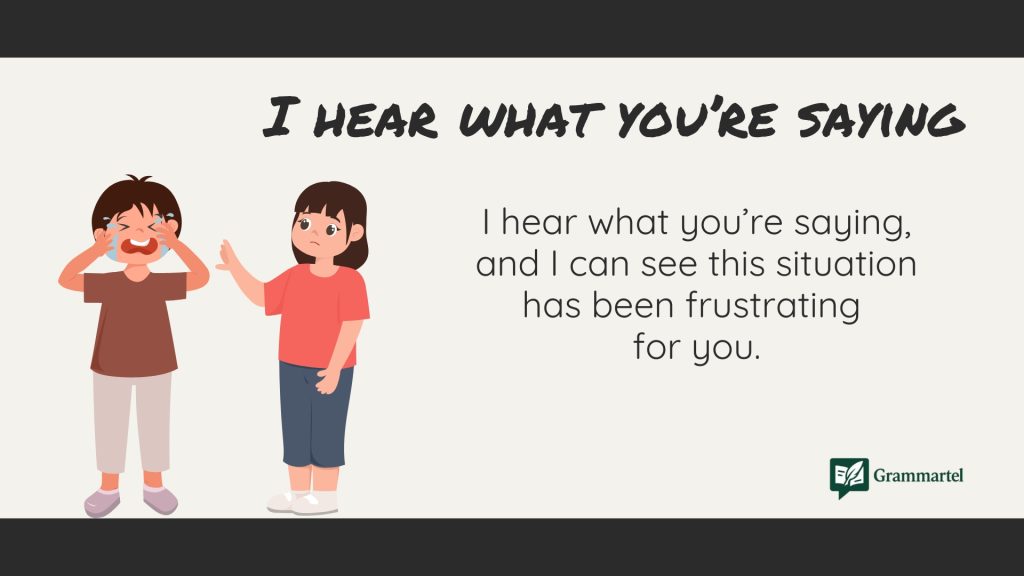
Meaning: I acknowledge your perspective without necessarily agreeing.
Explanation: This shifts focus from dismissing feelings to validating that they’ve been expressed.
Example: I hear what you’re saying, and I can see this situation has been frustrating for you.
Best Use: When someone wants to feel heard, not judged.
Worst Use: When the person is looking for a sincere apology for your own mistake.
Tone: Neutral, calm.
2. I understand this has been upsetting for you
Meaning: Recognition of emotional impact.
Explanation: Acknowledges their emotional experience, which can help de-escalate tension.
Example: I understand this has been upsetting for you, and I want to address your concerns.
Best Use: In professional situations where you need to show empathy without admitting fault.
Worst Use: When emotions are extremely high and they want an explicit apology.
Tone: Empathetic, measured.
Have a look at : 40 Best Ways to Say “Please Advise” (With Examples).
3. I can see why you’d feel that way
Meaning: Shows empathy by validating their perspective.
Explanation: Doesn’t dismiss feelings—connects to their reasoning.
Example: I can see why you’d feel that way given the delay in our response.
Best Use: Customer service or feedback situations.
Worst Use: If the person’s reaction is unreasonable or based on false assumptions.
Tone: Understanding, conciliatory.
4. That sounds frustrating
Meaning: Acknowledges the emotion (frustration) directly.
Explanation: Names the feeling to show active listening.
Example: That sounds frustrating—I’d be annoyed too if my order arrived late.
Best Use: Informal customer support or personal conversations.
Worst Use: High-stakes situations where deeper empathy or action is needed.
Tone: Relatable, human.
5. I get that this hasn’t been easy for you
Meaning: Shows awareness of difficulty without defensiveness.
Explanation: Validates their experience and offers compassion.
Example: I get that this hasn’t been easy for you, and I’m here to work toward a solution.
Best Use: Ongoing relationships (coworkers, clients, friends).
Worst Use: When there’s no intent to help resolve the problem.
Tone: Supportive, soft.
6. Thanks for sharing how you feel
Meaning: Expresses appreciation for their openness.
Explanation: Frames feedback as valuable, even if it’s hard to hear.
Example: Thanks for sharing how you feel—it helps us understand your perspective.
Best Use: Feedback sessions, reviews, or customer complaints.
Worst Use: Heated arguments where gratitude might feel forced.
Tone: Respectful, professional.
7. It’s clear this matters to you
Meaning: Acknowledges importance of the issue to them.
Explanation: Shows respect for their values or priorities.
Example: It’s clear this matters to you, and I don’t want that to be overlooked.
Best Use: Negotiations, conflict resolution.
Worst Use: When you have no intent to follow through.
Tone: Neutral with slight warmth.
8. I want to make sure I’m understanding you correctly
Meaning: Signals intent to clarify and engage.
Explanation: Shifts the focus from defending yourself to ensuring clarity.
Example: I want to make sure I’m understanding you correctly—you felt unsupported during the process?
Best Use: When emotions stem from misunderstandings.
Worst Use: If it sounds like a way to stall without action.
Tone: Curious, open.
9. Your experience is important to us
Meaning: Values their interaction, even if it was negative.
Explanation: Emphasizes their perspective matters to the relationship or service.
Example: Your experience is important to us, so we’re taking your feedback seriously.
Best Use: Professional customer service.
Worst Use: If the company doesn’t intend to address the issue.
Tone: Professional, empathetic.
10. I appreciate you bringing this up
Meaning: Gratitude for their honesty.
Explanation: Turns a potentially tense moment into constructive dialogue.
Example: I appreciate you bringing this up—it’s something we can work on.
Best Use: Workplace feedback, personal disagreements.
Worst Use: Situations where gratitude feels sarcastic or hollow.
Tone: Warm, constructive.
11. I respect your perspective
Meaning: Shows acknowledgment of their viewpoint, even without agreement.
Explanation: Communicates respect, which can help reduce defensiveness.
Example: I respect your perspective, and I’d like to understand more about what led you to feel this way.
Best Use: Professional disagreements, negotiations, or feedback discussions.
Worst Use: When the statement is insincere or dismissive.
Tone: Respectful, formal.
12. I can see this has impacted you
Meaning: Acknowledges that the situation has had a tangible effect on them.
Explanation: Shifts the focus from emotions alone to recognizing real impact.
Example: I can see this has impacted you, and I want to address it seriously.
Best Use: When someone has been affected by a decision, delay, or oversight.
Worst Use: If there’s no intention to address the root cause.
Tone: Concerned, understanding.
13. I’d feel the same in your situation
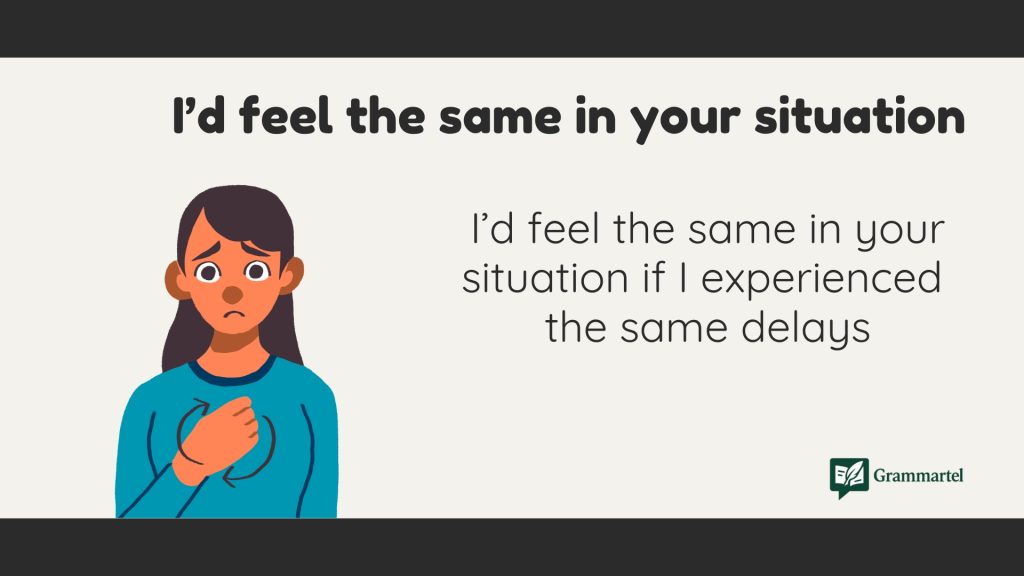
Meaning: Expresses solidarity and empathy.
Explanation: Helps create a shared emotional ground, showing you’d also react similarly.
Example: I’d feel the same in your situation if I experienced the same delays.
Best Use: Customer complaints, team conflict resolution, or personal relationships.
Worst Use: When the situation is unique and your claim feels performative.
Tone: Empathetic, relatable.
14. I want to better understand what’s upsetting you
Meaning: Opens a door for deeper dialogue.
Explanation: Focuses on curiosity and clarity instead of defensiveness.
Example: I want to better understand what’s upsetting you so we can address it.
Best Use: Complex issues with multiple contributing factors.
Worst Use: When the other person has already explained in detail and feels ignored.
Tone: Open, constructive.
15. Your feedback is valuable
Meaning: Positions their complaint or concern as something useful.
Explanation: Turns a negative experience into an opportunity for improvement.
Example: Your feedback is valuable, and we’re reviewing it to make changes.
Best Use: Customer service, internal team improvement.
Worst Use: If there’s no genuine plan to use the feedback.
Tone: Professional, appreciative.
16. I acknowledge your feelings
Meaning: Directly validates their emotions.
Explanation: Shows you’re listening without challenging how they feel.
Example: I acknowledge your feelings, and I want to address the issue.
Best Use: Emotional or high-stakes situations.
Worst Use: When the person needs tangible solutions, not just recognition.
Tone: Neutral, empathetic.
17. I realize this wasn’t the experience you expected
Meaning: Recognizes a mismatch between expectation and reality.
Explanation: Shows awareness that the result didn’t meet their hopes.
Example: I realize this wasn’t the experience you expected, and we’re working to improve.
Best Use: Customer service, user experience feedback.
Worst Use: Severe issues that require more than a gentle acknowledgment.
Tone: Understanding, slightly apologetic.
18. I take your concerns seriously
Meaning: Shows you value their concerns enough to act on them.
Explanation: Reinforces that the matter isn’t being brushed aside.
Example: I take your concerns seriously and will ensure they’re addressed promptly.
Best Use: Escalated issues or formal complaints.
Worst Use: If no follow-up action will be taken.
Tone: Formal, sincere.
19. I want to address this constructively
Meaning: Sets a tone of problem-solving.
Explanation: Moves the discussion toward resolution rather than conflict.
Example: I want to address this constructively so we can find a path forward.
Best Use: Workplace disagreements or partnership challenges.
Worst Use: When emotions are still too high for constructive dialogue.
Tone: Neutral, solution-focused.
20. I appreciate you trusting me with this feedback
Meaning: Recognizes the vulnerability or effort involved in sharing criticism.
Explanation: Strengthens trust by appreciating their openness.
Example: I appreciate you trusting me with this feedback—it helps us grow.
Best Use: One-on-one meetings, sensitive conversations.
Worst Use: If the feedback will not actually be valued or acted upon.
Tone: Warm, appreciative.
21. I see where you’re coming from
Meaning: Acknowledges the logic behind their feelings.
Explanation: Shows you’ve considered their perspective instead of dismissing it.
Example: I see where you’re coming from, and I’d like to work toward a resolution.
Best Use: Conversations where understanding is key, such as negotiations or debates.
Worst Use: When emotions are raw, and they want a direct apology instead of logic.
Tone: Neutral, understanding.
22. I recognize how this situation affected you
Meaning: Admits awareness of their personal impact.
Explanation: Gives weight to their emotions without arguing over facts.
Example: I recognize how this situation affected you, and I take that seriously.
Best Use: Professional or personal situations with clear consequences.
Worst Use: If you aren’t actually planning to address the consequences.
Tone: Sincere, professional.
23. I want to find a way forward together
Meaning: Focuses on collaboration instead of blame.
Explanation: Shifts the conversation toward teamwork and problem-solving.
Example: I want to find a way forward together so we can both feel comfortable.
Best Use: Disputes in ongoing relationships—colleagues, partners, or friends.
Worst Use: When there’s no real interest in collaboration.
Tone: Cooperative, forward-looking.
24. I know this hasn’t been ideal
Meaning: Acknowledges the imperfection of the situation.
Explanation: Shows honesty and self-awareness without over-apologizing.
Example: I know this hasn’t been ideal, and I’m committed to improving things.
Best Use: Situations where full resolution will take time.
Worst Use: Serious mistakes that need a direct apology.
Tone: Humble, candid.
25. I can imagine how that felt
Meaning: Demonstrates empathy by picturing their experience.
Explanation: Creates connection by acknowledging the emotional weight.
Example: I can imagine how that felt, and I’d like to make things right.
Best Use: Personal conversations, customer complaints.
Worst Use: Overly formal or technical discussions.
Tone: Empathetic, personal.
26. I hear the frustration in your voice
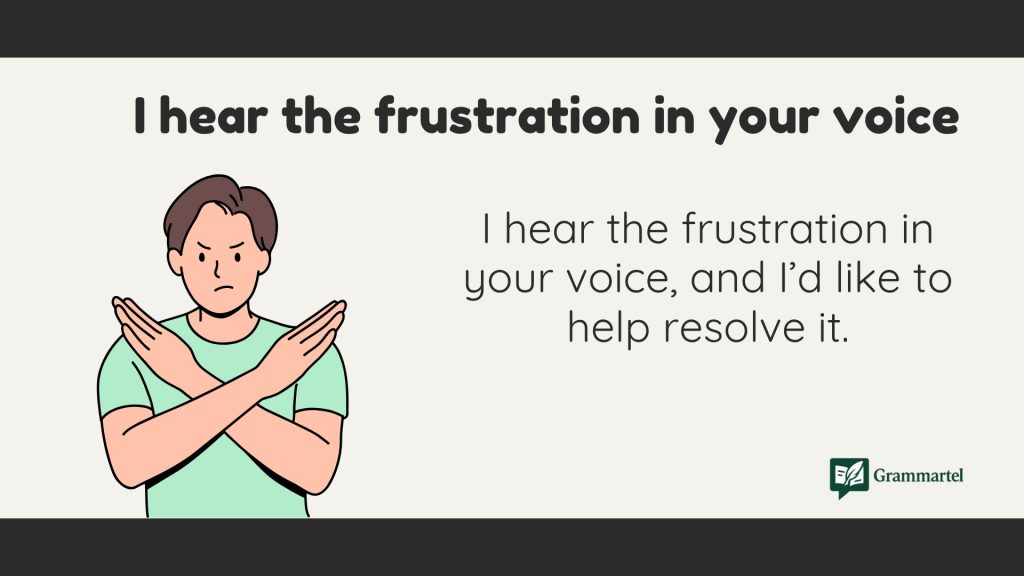
Meaning: Identifies and validates their emotion.
Explanation: Shows active listening by naming what you notice.
Example: I hear the frustration in your voice, and I’d like to help resolve it.
Best Use: Live conversations—calls, meetings.
Worst Use: Written communication where tone can’t be confirmed.
Tone: Attentive, empathetic.
27. I take responsibility for hearing you out fully
Meaning: Commits to giving them space to express themselves.
Explanation: Shifts to an active listening role, showing patience and respect.
Example: I take responsibility for hearing you out fully before responding.
Best Use: Conflicts that require careful listening to resolve.
Worst Use: Time-sensitive situations where action is more urgent than listening.
Tone: Calm, deliberate.
28. I respect that this matters deeply to you
Meaning: Shows acknowledgment of their priorities.
Explanation: Recognizes the weight the issue holds for them personally.
Example: I respect that this matters deeply to you, and I don’t take it lightly.
Best Use: Value-based disagreements or decisions.
Worst Use: When you don’t actually plan to respect their concerns in practice.
Tone: Respectful, serious.
29. I want to understand your expectations better
Meaning: Seeks clarity on what they need.
Explanation: Turns the conversation toward alignment and solutions.
Example: I want to understand your expectations better so I can respond effectively.
Best Use: Service issues, team dynamics, project concerns.
Worst Use: When you already know their expectations but can’t meet them.
Tone: Constructive, curious.
30. I acknowledge this hasn’t gone as planned
Meaning: Admits deviation from expectations without assigning blame.
Explanation: Validates their disappointment while keeping the focus forward.
Example: I acknowledge this hasn’t gone as planned, and I’d like to discuss next steps.
Best Use: Project updates, performance reviews, or service complaints.
Worst Use: When the outcome is significantly worse than “not as planned.”
Tone: Professional, composed.
31. I want to make things right where I can
Meaning: Expresses willingness to take corrective action.
Explanation: Balances acknowledgment of the issue with a readiness to help.
Example: I want to make things right where I can, even if we can’t fix everything immediately.
Best Use: Customer service, relationship repair.
Worst Use: When there’s nothing you can realistically do to improve the situation.
Tone: Solution-oriented, compassionate.
32. I understand this has caused inconvenience
Meaning: Recognizes disruption or extra effort caused by the situation.
Explanation: Gives weight to the practical impact of the issue.
Example: I understand this has caused inconvenience, and I’ll work to prevent it in the future.
Best Use: Service delays, process errors.
Worst Use: When the problem caused significant harm beyond “inconvenience.”
Tone: Formal, apologetic.
33. I take your point seriously
Meaning: Shows their perspective is being taken into account.
Explanation: Communicates respect for their input without arguing.
Example: I take your point seriously, and I’ll make sure it’s factored into our decision-making.
Best Use: Professional disagreements, strategic discussions.
Worst Use: If you’re just saying it to end the conversation.
Tone: Respectful, professional.
34. I know this isn’t what you were hoping for
Meaning: Acknowledges disappointment or unmet expectations.
Explanation: Recognizes their emotional letdown in a straightforward way.
Example: I know this isn’t what you were hoping for, and I’d like to find a better solution.
Best Use: Delivering unwelcome news tactfully.
Worst Use: Severe or repeated failures.
Tone: Honest, empathetic.
35. I value the time you took to explain this
Meaning: Expresses gratitude for their effort in communicating.
Explanation: Turns a potentially negative exchange into an appreciated contribution.
Example: I value the time you took to explain this—it gives us a clearer path forward.
Best Use: Feedback sessions, customer concerns.
Worst Use: When the statement feels like empty politeness.
Tone: Appreciative, professional.
36. I realize this has been a recurring issue for you
Meaning: Acknowledges patterns or repeated frustrations.
Explanation: Shows awareness of ongoing challenges rather than treating them as isolated.
Example: I realize this has been a recurring issue for you, and I’d like to break that cycle.
Best Use: Long-term service relationships, workplace challenges.
Worst Use: If there’s no actual plan to prevent recurrence.
Tone: Understanding, responsible.
37. I see this has been a source of stress
Meaning: Validates emotional strain caused by the issue.
Explanation: Shows that you notice the personal toll of the situation.
Example: I see this has been a source of stress, and I’d like to help lighten that load.
Best Use: Workplace conflicts, customer care, personal disputes.
Worst Use: Trivial matters where “stress” might sound exaggerated.
Tone: Supportive, empathetic.
38. I want to ensure your concerns are addressed
Meaning: Signals commitment to follow-through.
Explanation: Moves from acknowledgment to action.
Example: I want to ensure your concerns are addressed so you feel confident moving forward.
Best Use: Customer service escalations, professional disputes.
Worst Use: If there’s no follow-up or accountability.
Tone: Professional, reassuring.
Also Read : 40 Other Ways to Say “What Are the Next Steps?” (With Examples).
39. I recognize this was frustrating to deal with
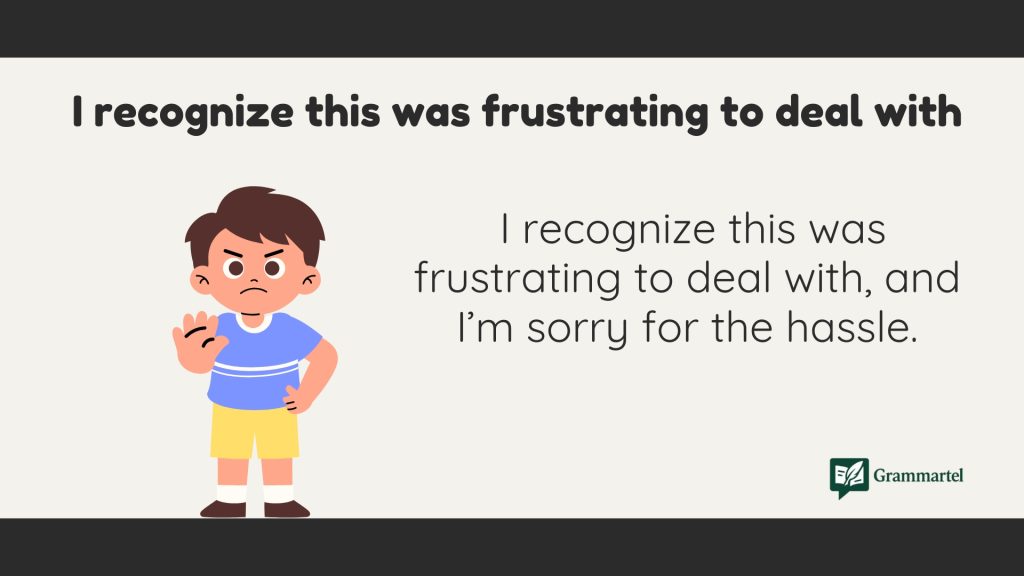
Meaning: Names the frustration they’ve experienced.
Explanation: Shows empathy without defensiveness.
Example: I recognize this was frustrating to deal with, and I’m sorry for the hassle.
Best Use: Minor to moderate service complaints, work miscommunications.
Worst Use: Major issues that require a stronger statement than “frustrating.”
Tone: Empathetic, casual.
40. I’m committed to improving this going forward
Meaning: Focuses on future improvement rather than the past.
Explanation: Demonstrates accountability and commitment to better outcomes.
Example: I’m committed to improving this going forward so we don’t run into the same problem again.
Best Use: Long-term relationships, ongoing projects, service recovery.
Worst Use: When there’s no real plan or ability to improve.
Tone: Responsible, forward-focused.
Conclusion
Replacing “I’m sorry you feel that way” with warmer words can change the whole tone of a conversation. The right phrase shows you’re listening and willing to understand. It’s not about agreeing with everything—it’s about being respectful and clear. With these 40 examples, you’ll have plenty of ways to handle tough moments with kindness and confidence. A little thoughtfulness can make every interaction smoother.
Keep your learning mode on with Grammartel.

